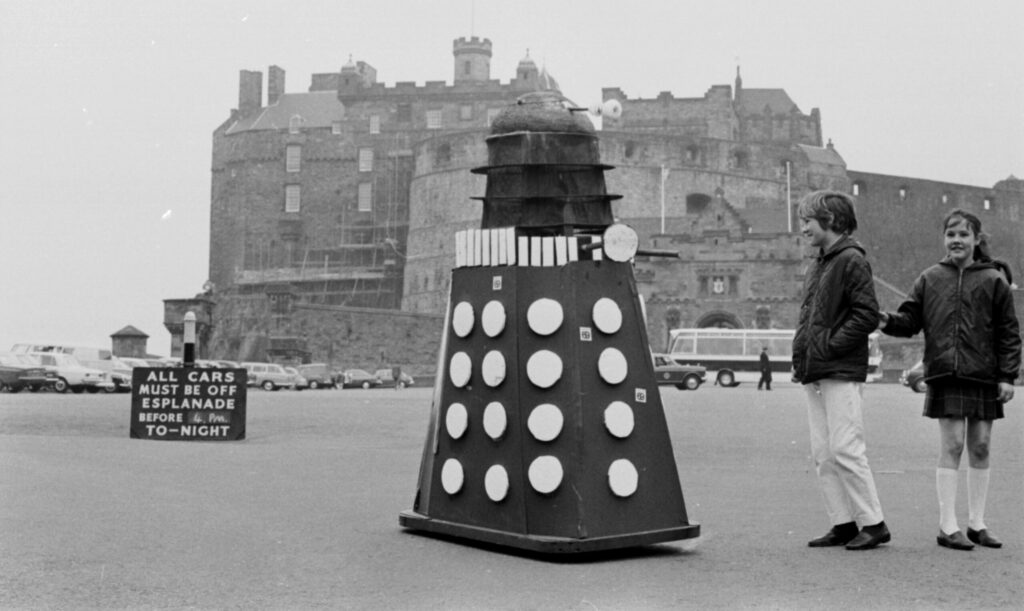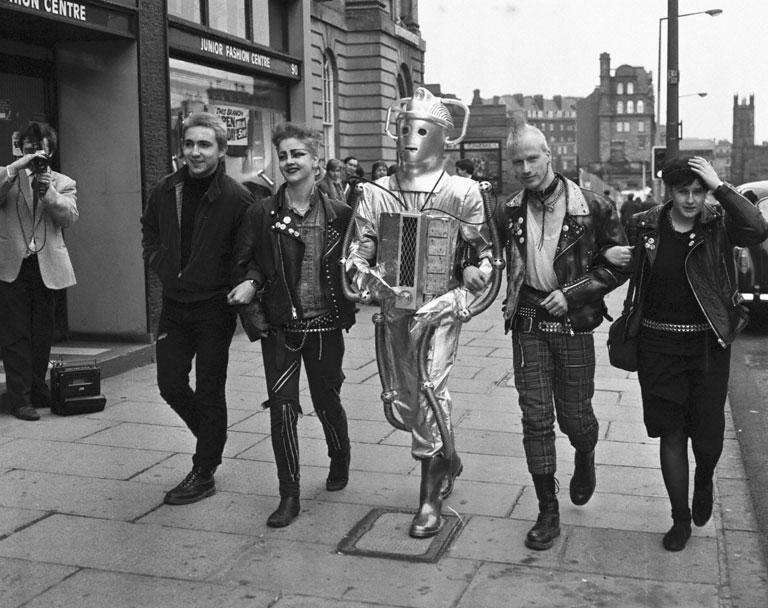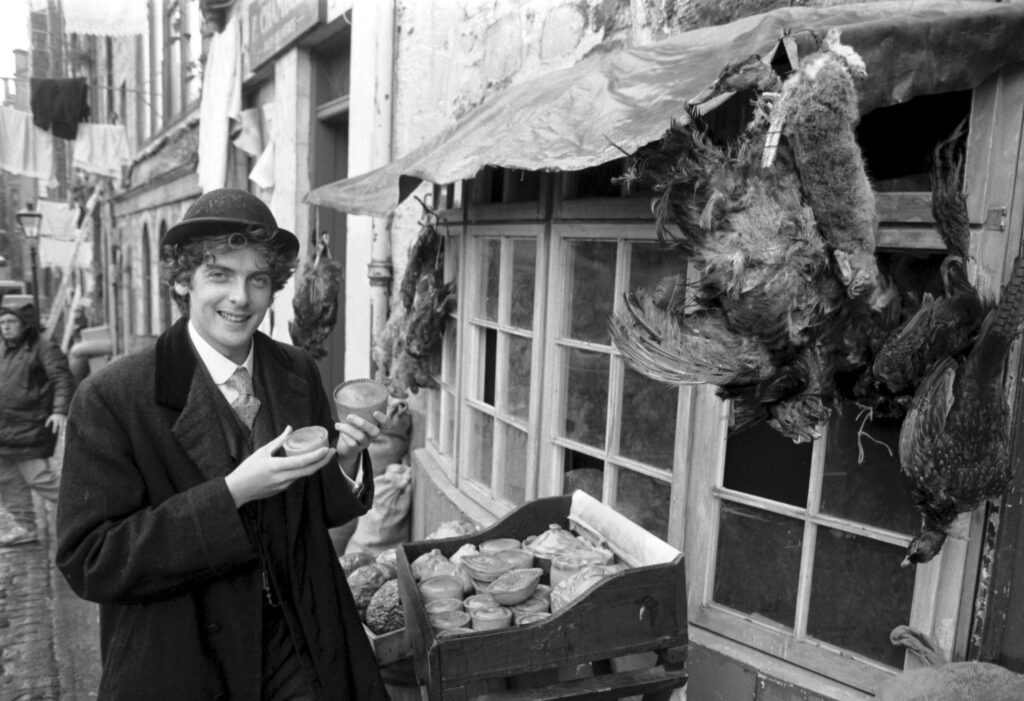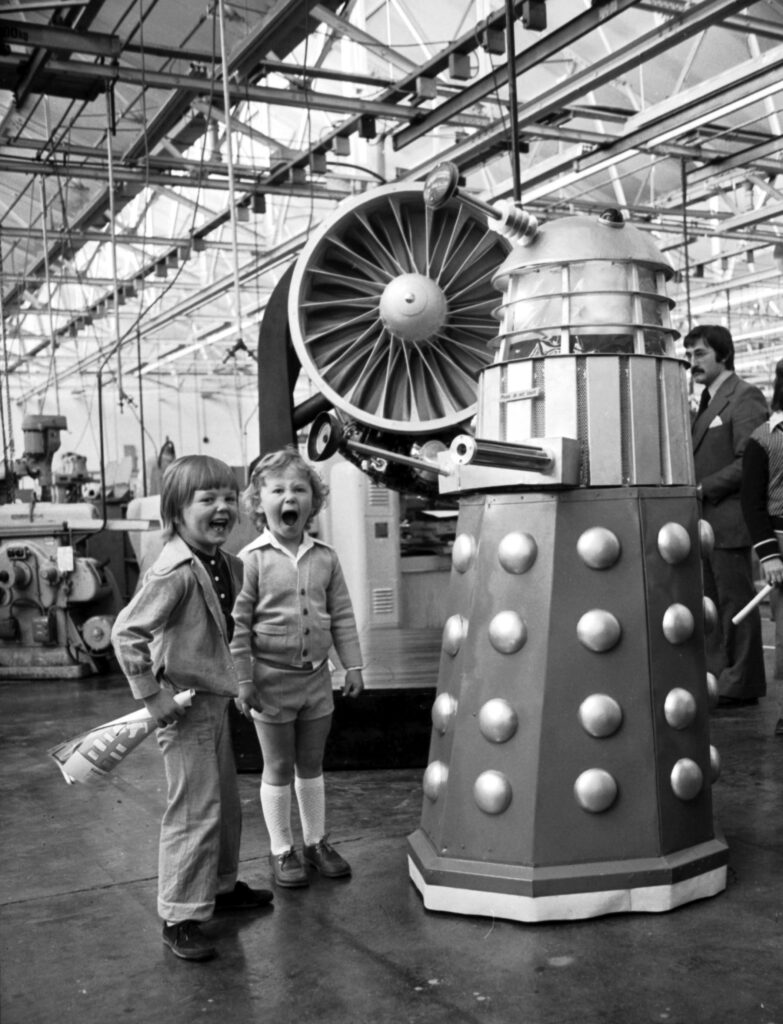This year marks the 60th anniversary of the Doctor and their many companions gracing our telly screens. But did you know there’s more linking Doctor Who and Scotland than Ncuti Gatwa, David Tennant, Peter Capaldi and Sylvester McCoy? From a Dalek trying to exterminate Edinburgh Castle to ‘Terror of Zygons’, here are some of our favourite memories of 60 years of McWibbly wobbly timey wimey stuff.
⚠️ And in the words of River Song: tread with caution because there are “spoilers” ahead! ⚠️
The father of the TARDIS
The TARDIS, short for “Time And Relative Dimension In Space”, is famous for being able to adopt any shape or size to disguise itself. Due to a malfunction of its chameleon circuit, the Doctor’s TARDIS is stuck in the shape of a common 1960s telephone police box.
The TARDIS is modelled on the ‘Type 2 Mackenzie-Trench Police Call Box’. Scottish architect Gilbert Mackenzie Trench was the principal Architect and Surveyor for the Metropolitan Police. He designed the iconic blue Metropolitan Police box in the 1920s.

Glasgow, 57-59 Cornwall Street, 1967. Most police boxes were blue except for the ones in Glasgow which used to be red. Many of them were later painted blue to match their English counterparts. Zoom in on this TARDIS in Glasgow on Canmore.
Each box served as a ‘miniature police station’ for officers. They were equipped with a telephone, incident book, fire extinguisher and first-aid kit.
It doesn’t look very roomy, but the police box could even hold prisoners on a temporary basis. Bigger on the inside? No. Unless the police aren’t telling us something…
Some of the earliest public police telephone boxes appeared in Glasgow, in 1891. The tall, thin, hexagonal-shaped boxes still looked very different to Mackenzie Trench’s model. His design was simple, functional and used concrete for extra durability.
The instantly recognisable boxes were a focal point where the public could make enquiries and call for help.
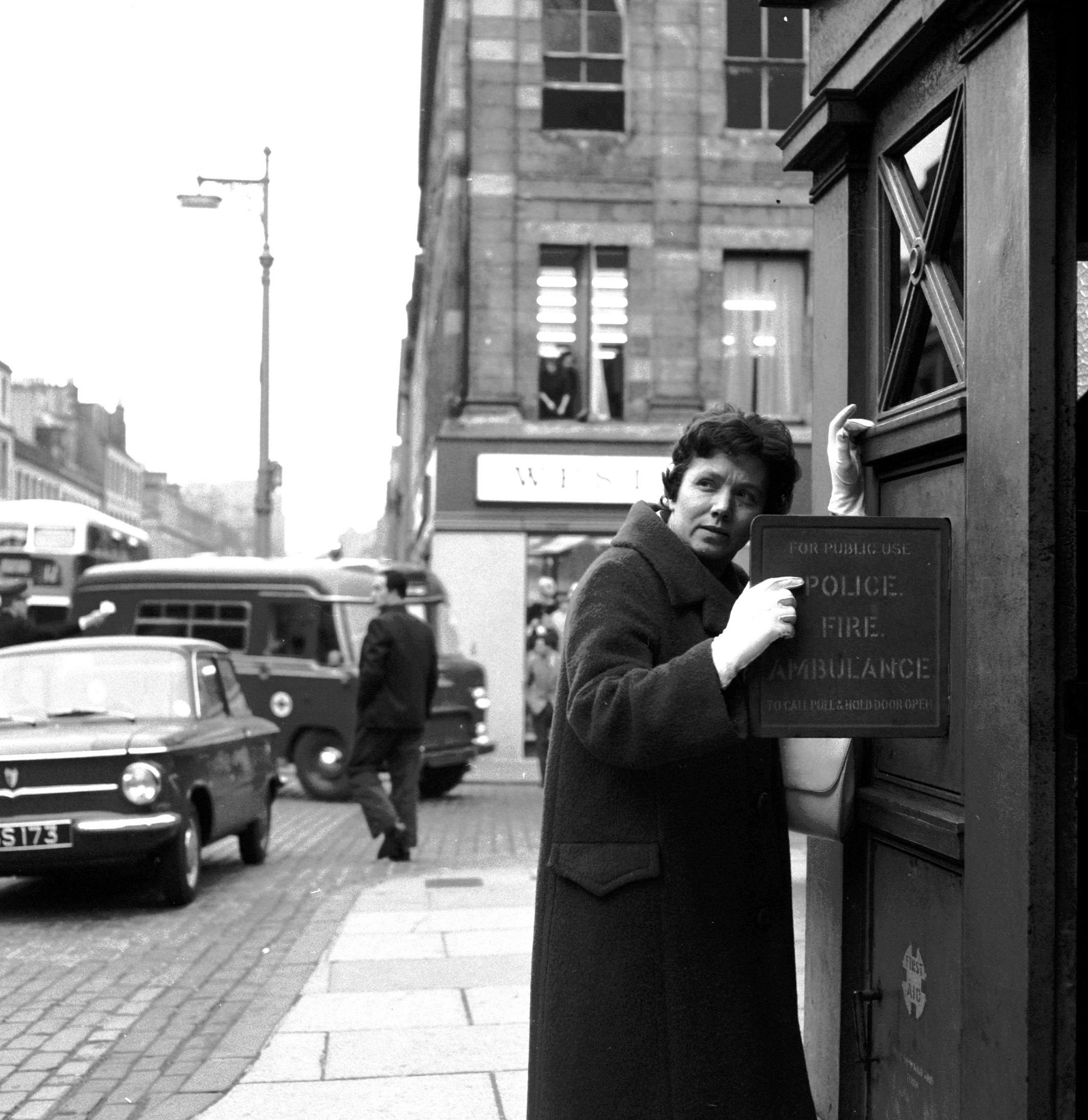
Is it a common police box? Is it an Edinburgh TARDIS and a new companion in disguise? Who knows! © The Scotsman Publications Ltd. Licensor www.scran.ac.uk
How many police officers can you fit inside a TARDIS?
Did you know Glasgow used to have the highest ratio of boxes to police officers in Britain? Between 1932 and 1938, 323 police boxes were placed in the city.
The famous police boxes that you can still spot at Buchanan Street and Cathedral Square are two of the very rare, surviving examples of Mackenzie Trench’s Metropolitan police box in Britain.

The Cathedral Square police box is particularly rare. We listed this police box, along with three other surviving police boxes on the streets of Glasgow. It’s one the last few of thousands that once graced the streets of Britain between 1932 and 1938.
Edinburgh’s police boxes, introduced in the early 1930s, were different from the standard Metropolitan police boxes. They were unique to Edinburgh and designed to complement the city’s architecture.
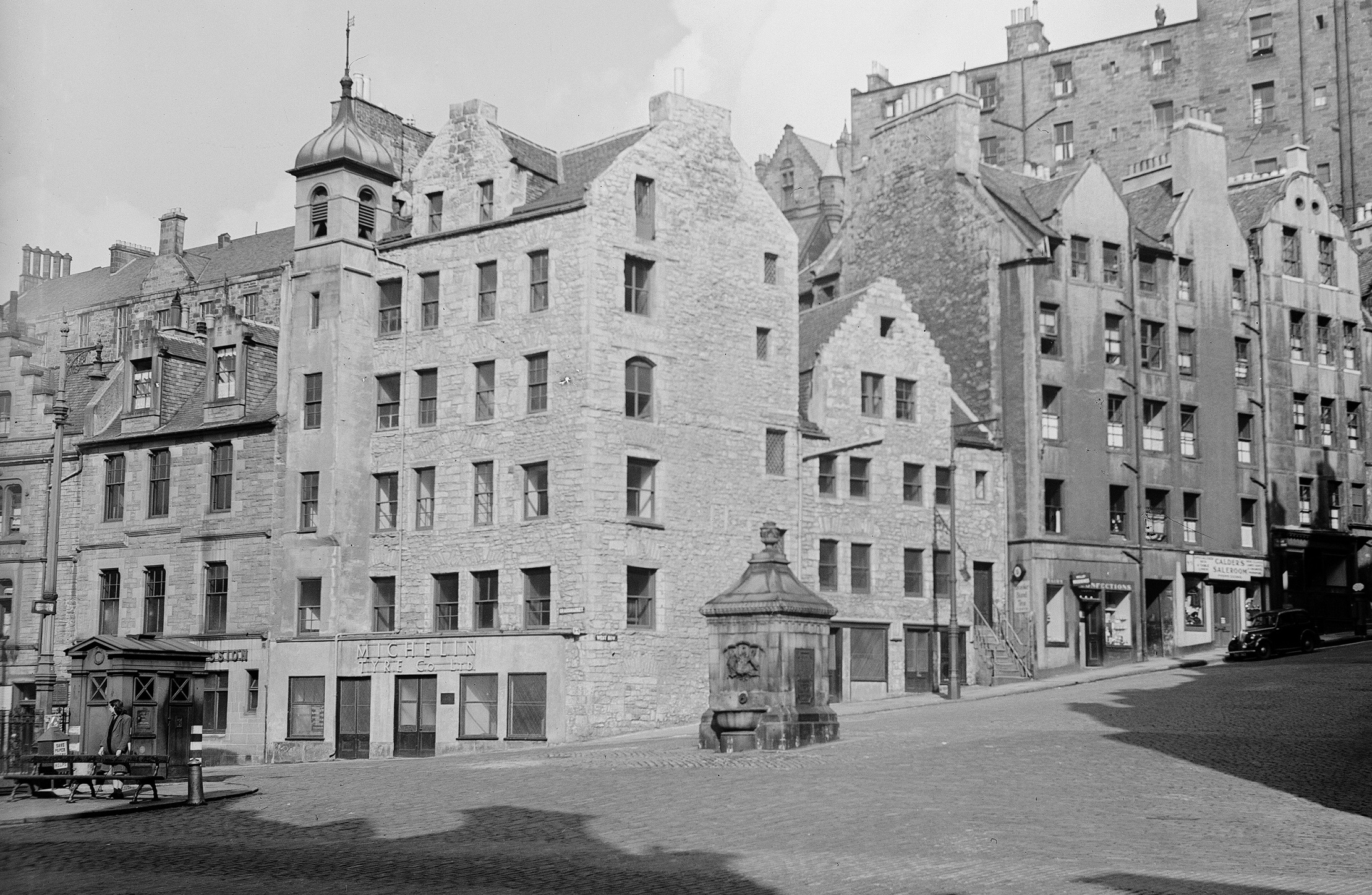
An Edinburgh police box at the Grassmarket in 1950. Zoom in on Canmore
Former city architect Ebenezer James MacRae designed the Edinburgh police boxes. (He’s probably unrelated to Tom MacRae, writer of ‘Rise of the Cybermen’ and ‘The Girl Who Waited’). The cast iron boxes were installed between 1931 and 1933 and likely manufactured by Carron Ironworks in Falkirk. During that period, the city installed 85 police boxes.
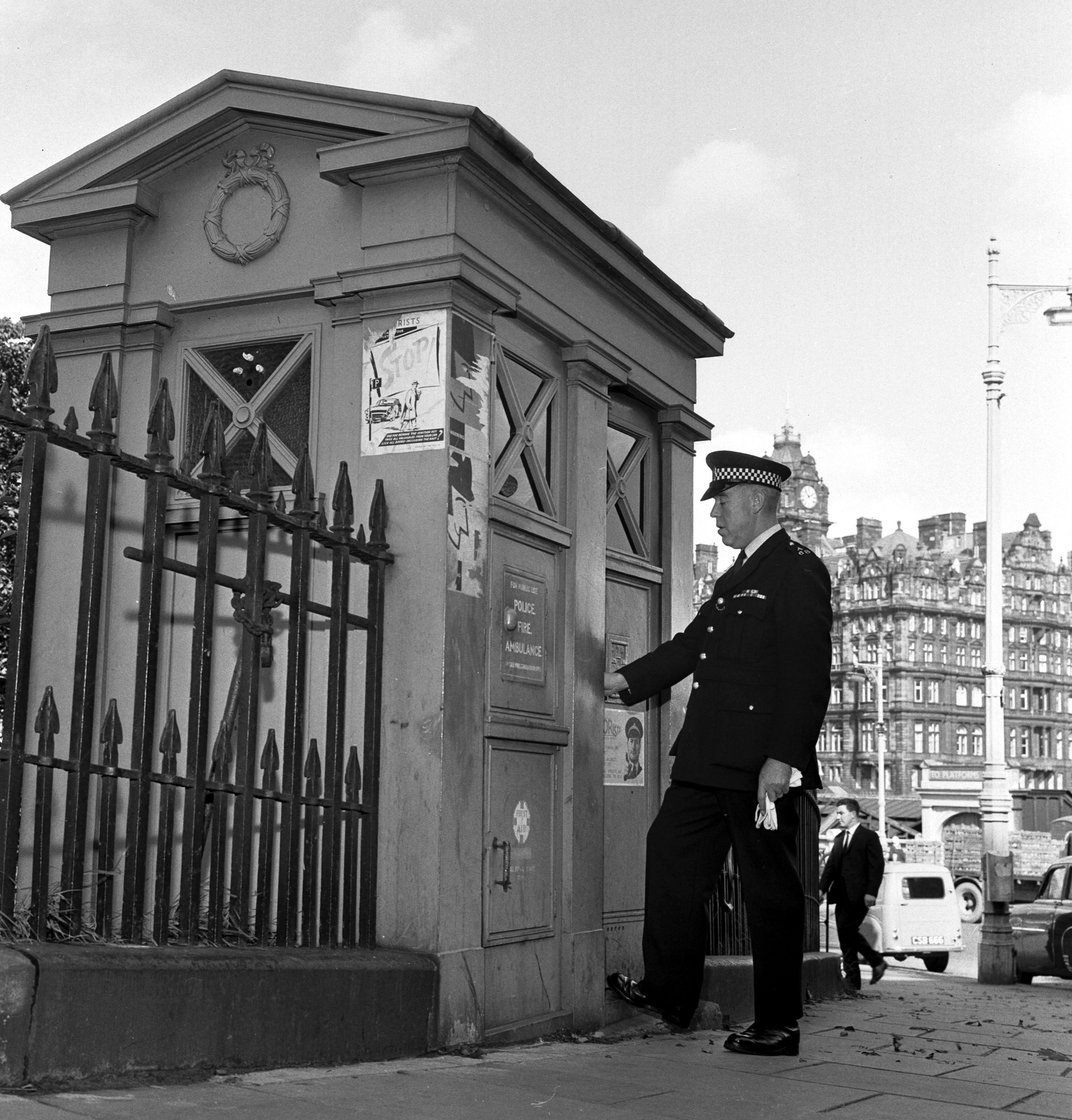
A senior police officer opens the door of a Police Box in Market Street, Edinburgh. © The Scotsman Publications Ltd. Licensor www.scran.ac.uk
With the introduction of the pocket radio and the panda car, police boxes gradually became obsolete.
Many have now been sold off and turned into cafes, tourist information points or even art galleries.
TARDIS – Time and Relative Dimension in Scotland
Of course, we can still see the iconic blue box on our television screens – but how many times has the TARDIS found her way to Scotland?
Our historic places have provided inspiration for many an epic tale, and often play a starring role on the big and the small screen. Doctor Who is no exception. The Doctor is even said to have attended the University of Glasgow!
Skye’s Dunvegan Castle appears in “Terror of Zygons“, a 1975 adventure featuring the Fourth Doctor and Sarah-Jane Smith. The home to the chief of Clan MacLeod has dramatically overlooked Loch Dunvegan since at least the 13th century.
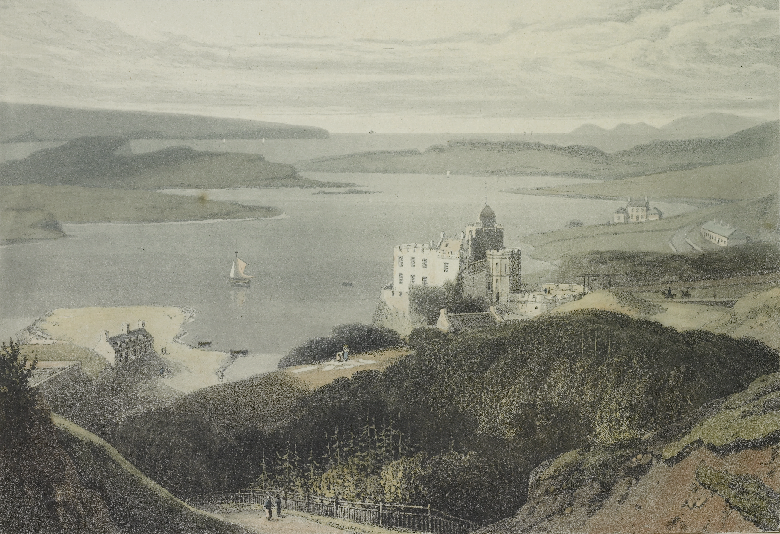
An 1819 engraving of Dunvegan Castle © Courtesy of HES.
In the show, it’s used as the exterior of the fictional Forgill Castle, home to the Duke of Forgill, who has been taken over by Broton, leader of the Zygons. A secret passage leading from the castle to a spaceship at the bottom of Loch Ness doesn’t form part of our Category A listing!
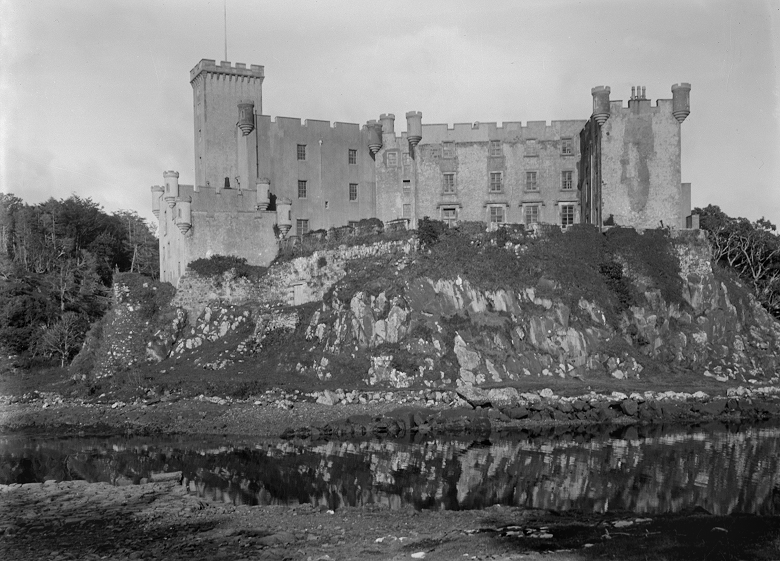
Dunvegan castle in 1922 © Courtesy of HES.
Further east, Royal Deeside’s strong associations with Queen Victoria inspired 2006’s Tooth and Claw, which, via a battle with an extra-terrestrial werewolf, explains the origins of the Torchwood Institute. Craig-y-Nos Castle in Wales stands in for Balmoral Castle, but as a Scots baronial-style country house, it’s a pretty good fit!
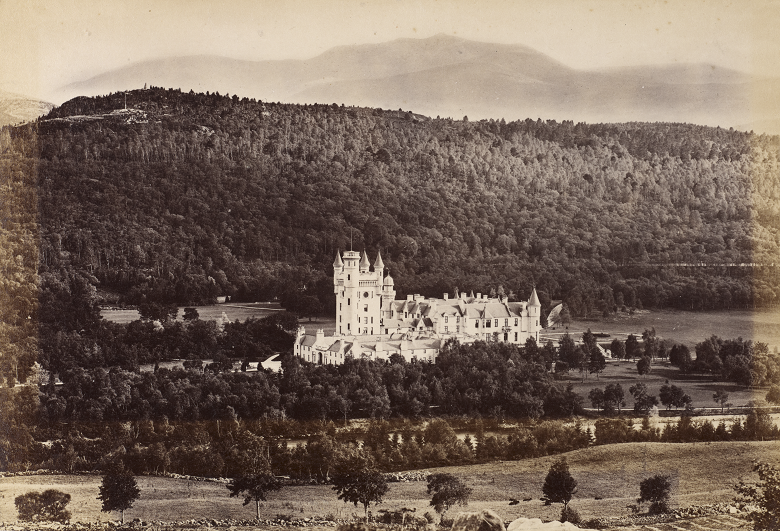
Balmoral Castle with Lochnagar in the background. This photo is from 1880, a year after the Doctor’s fictional encounter with Queen Victoria © Courtesy of HES.
The Doctor in Scottish History
The Tenth Doctor and companion Rose accidentally land in 1879 and encounter Victoria’s coach as it makes its way to her Highland estate, a fallen tree having prevented travel by rail. In real life, Victoria would have arrived at Ballater Station.
Royal trains made the journey from Aberdeen in around 75 minutes, because the Queen was not a fan of higher speeds. We imagine she wouldn’t be amused by a ride in the TARDIS.
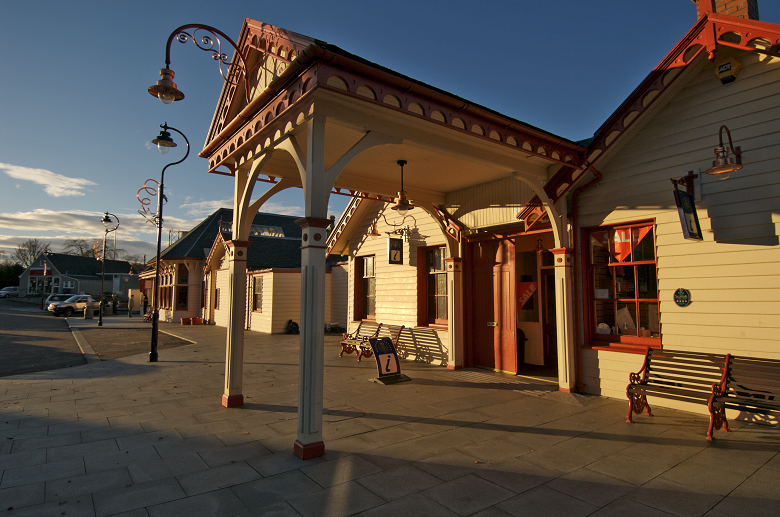
As terminus of the Deeside Railway and the closest station to Balmoral, Category B-listed Ballater Station often witnessed royal visitors © Crown Copyright: HES
Another notable Scottish storyline sees the Second Doctor run into a group of desperate Jacobites before being captured by government troops in the wake of the Battle of Culloden.
Amidst the mayhem, Frazer Hines makes his debut as Jamie McCrimmon, the Second Doctor’s longest serving companion. The episode from 1966 concludes with young Jamie promising to teach the Doctor how to play the bagpipes. But the Doctor’s recorder hasn’t been swapped for a chanter just yet.
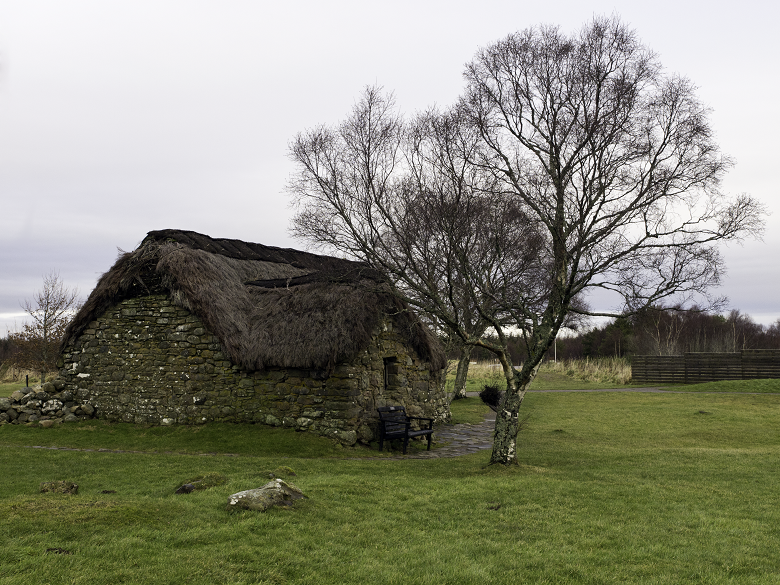
Leanach Cottage on the eastern side of the Culloden Battlefield. A group of defeated Jacobites hide in a similar cottage with the Doctor and his companions. © Crown Copyright: HES
While you can check out Terror of Zygons and Tooth and Claw on the BBC iPlayer, you’ll not be able to find The Highlanders. All four episodes of are sadly missing from the archives, though there are plans to add the surviving audio to BBC Sounds and to animate missing episodes.
A Lasting Legacy
Scotland’s history, architecture and acting talent have given a lot to Doctor Who – and it’s clear from our archives that the show has had a lasting impact on us too!
Over in Scran you can find newspaper archive images of Scottish children meeting Tom Baker in 1975 and punks walking down Lothian Road with a Cyberman in 1983.
But the evil Daleks, designed by Terry Nation very near the show’s inception in 1963, are one of the most often repeated symbols of the show in our incredible archive of social history.
A quick scroll shows us children meeting a Dalek at a Hillington Rolls Royce Factory Open Day in 1975, a Dalek attending an author visit to Lanark Grammar School in 1995 and even a Dalek at the Gallery of Modern Art in 1996.
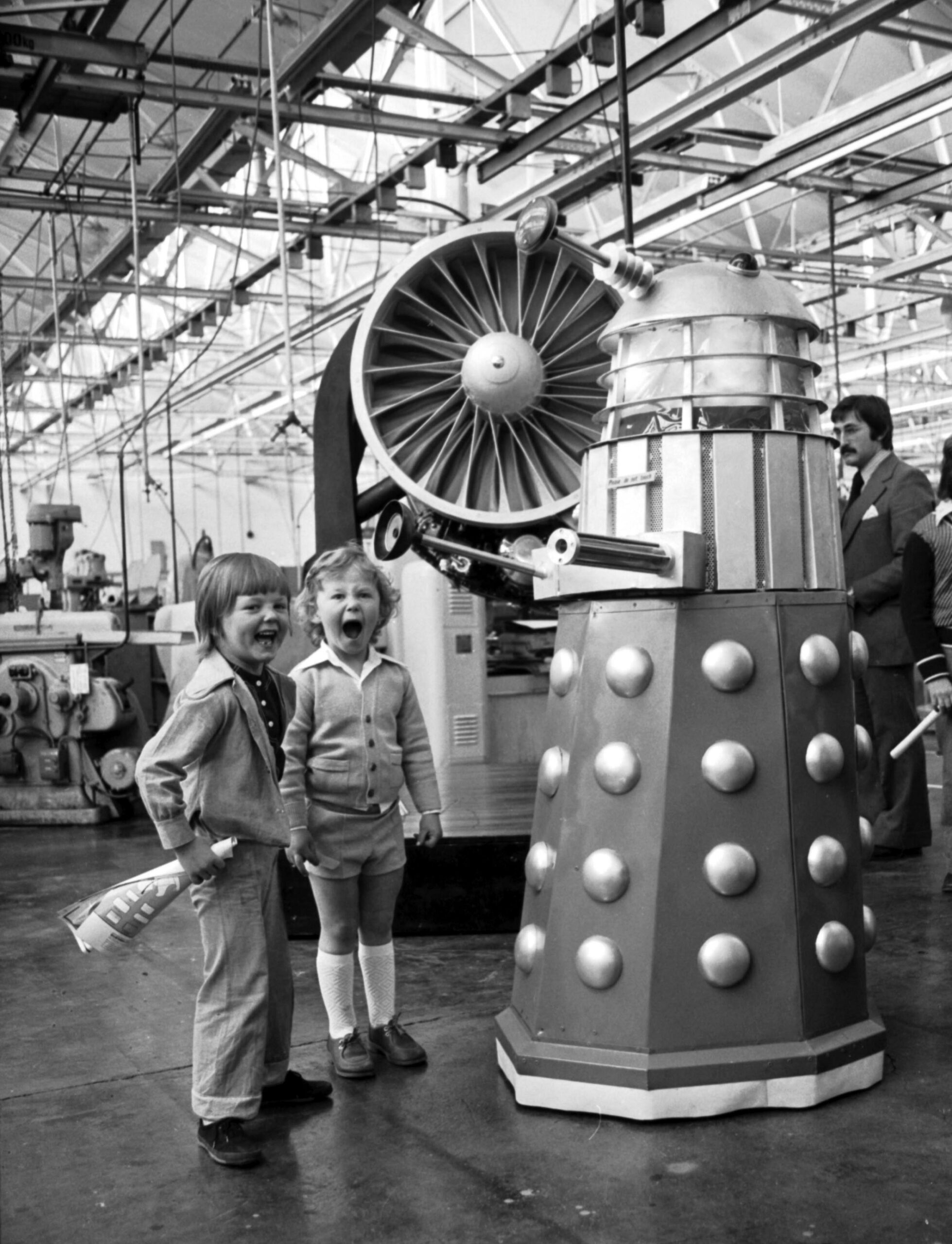
Little boys Adam Sherman and Paul Campbell meet a Dalek during the Rolls Royce Open Day at Hillington near Glasgow in May 1975. © The Scotsman Publications Ltd. Licensor www.scran.ac.uk
Perhaps our favourite images, though, are those where the villainous pepper pots have been re-created by enthusiastic fans.
We have a Dalek at Edinburgh Castle, the feature image of this very blog post, which was made by university students as part of charities week and photographed by Scotsman photographer Dick Ewart for the paper in 1969.
And finally, this mock-up Dalek at a Christmas party for firemen and children in the Lauriston Fire Station.
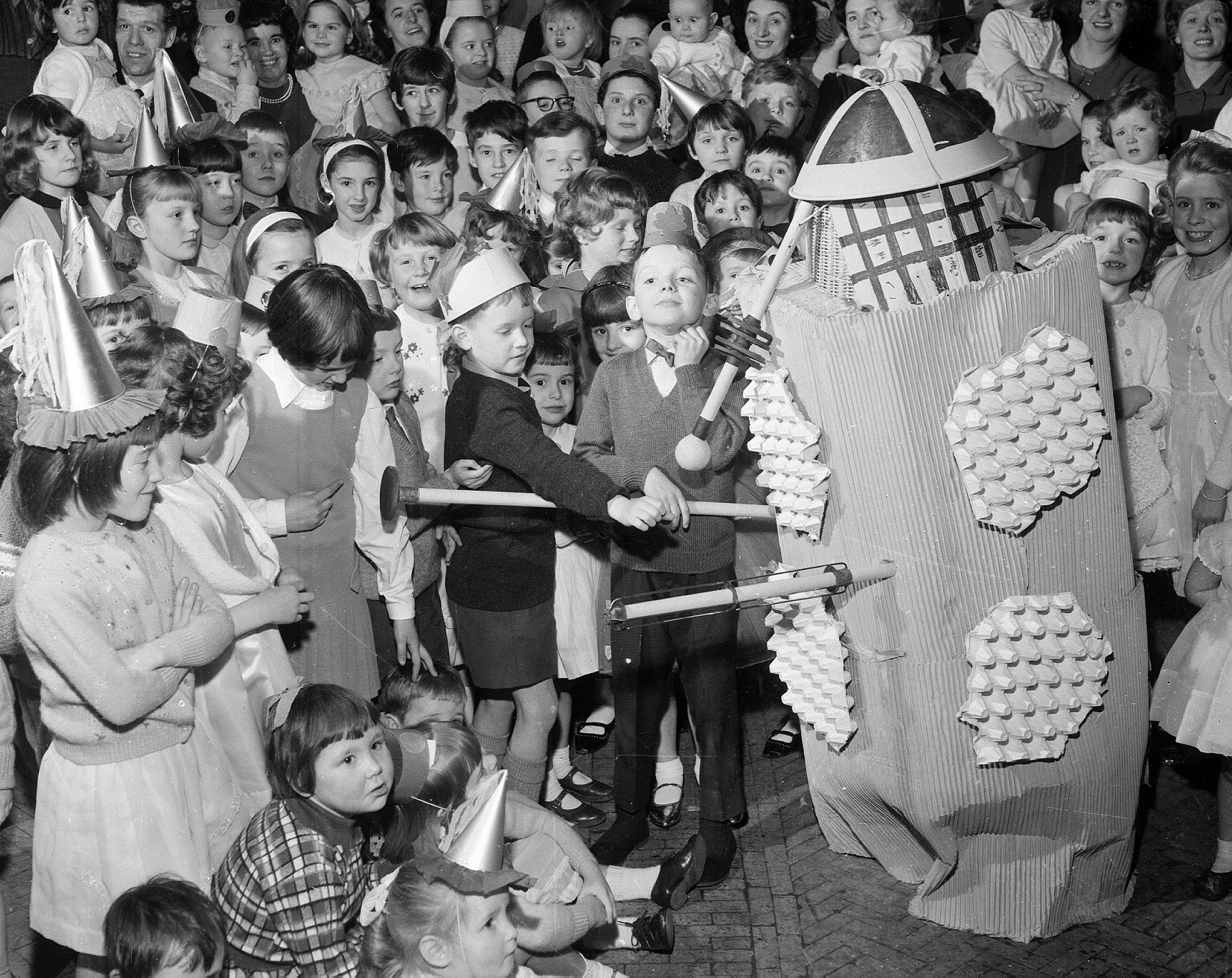
Did you meet the Dalek? © The Scotsman Publications Ltd. Licensor www.scran.ac.uk
We know the date in the archive for this photo must be wrong. It’s attributed as being taken in 1960 – three years before Doctor Who first aired.
If you were in attendance, we’d love to hear when the party was (assuming you survived).
About the Authors
Ali George, Samuel Wilson and Alea Ibrahim from the Digital Content team wrote this blog for the Doctor Who anniversary. We don’t just write Doctor Who blogs, we also put the stories on social media. Find us at @HistEnvScot and say hi! We’re off to plan an office rewatch of Doctor Who now.
Header image: A Dalek invading Edinburgh Castle?! Students from The University of Edinburgh made the model, likely for charities week, in April 1969.© The Scotsman Publications Ltd. Licensor www.scran.ac.uk

